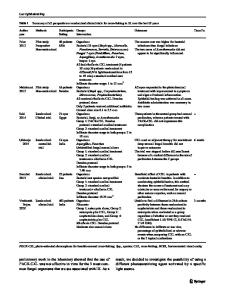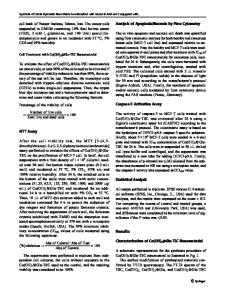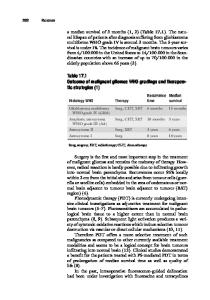Synthesis and characterization of functionalized nano magnetite with phthalocyanines for use in photodynamic therapy
- PDF / 612,073 Bytes
- 7 Pages / 612 x 792 pts (letter) Page_size
- 20 Downloads / 288 Views
ation with hidroxile groups. 100 mg of nano-magnetite was suspended in 100 mL of 5mM NaOH solution. The mixture was sonicated for 10 minutes and then stirred for another 10 minutes. The product was washed using methanol and dried. Amino-silanization. 5 mg of previously stabilized nano-magnetite was suspended in 2 mL of DMF. 20 mL of APTES added to the suspension of magnetite. The mixture was sonicated for 2 minutes and then stirred for 5 hours. The product was washed using methanol and dried. Anchorage of Nickel (II) Phthalocyanine. 5 mg of APTES coated nano-magnetite was suspended in 2 mL of DMF. 5 mL of 10 mM phthalocyanine solution added to the suspension of magnetite. The mixture was sonicated for 2 minutes and then stirred for 5 hours. The final product was dried with methanol. Superoxide production test The experiments of O2•— generation were repeated three separate times. The version 8 JMP software from SAS, was used for statistical analysis. Statistical analysis of the mean difference between multiple groups was determined by one-way analysis of variance followed by Tukey–Kramer multiple comparison tests. The alpha level for all tests was 0.05. RESULTS AND DISCUSION The nano magnetite obtained was characterized for X-ray diffraction (XRD). To determine the shape and particle size, it was used the Transmission electron microscopy (TEM) and zsize analyzer. The particle sizes obtained were of 30 to 15 nm as show the figure 1.
Porcentaje de particulas (%)
30 25 20 15 10 5 0
8.5
11.5 14.5 17.5 20.5 23.5 26.5 D (nm)
Figure 1. TEM micrograph and histogram of size distribution of magnetite co – precipitation synthesis The nanoparticles were stabilized by groups –OH in their surface. Ahead of that the modification of the nanoparticles surface its been realized with aminepropyltriethoxysilane (APTES) and nickel(II) phthalocyanine-tetrasulfonic acid tetrasodium salt. The results showed colloidal stable particles in phosphate buffer of pH:7.4 and ionic strenght of 100 mM with Z potential of -35 mV and a hydrodynamic radius since 200 nm to 80 nm.
ROS production
6 5
[O2•‾] (µM)
Co-precipitation synthesis 4 Co-precipitation with PEG synthesis
3
Mechanical synthesis 2 Commercial
1 0
Visible light
Ultraviolet Light PHOTO-STIMULATION
Darkness
Figure 2. Quantification of ROS production by nano-magnetite functionalized with NiPc after 240 minutes in different lighting conditions. ROS are known to mediate cell death in a variety of cell types [24].It is well known that phthalocyanines exhibit a high aggregation tendency and can form dimeric and oligomeric species in solution owing to their extended π system [25]. An advantage of association between NP and PCs consists in that administration may be controlled by means of colloidal stabilization of NP. The functionalization of magnetic nanoparticles with phthalocyanines is a great field of research due to the existence of a wide range of possibilities for the incorporation of organic substituents or metal centers in the phthalocyanine molecule, which can lead to t
Data Loading...











